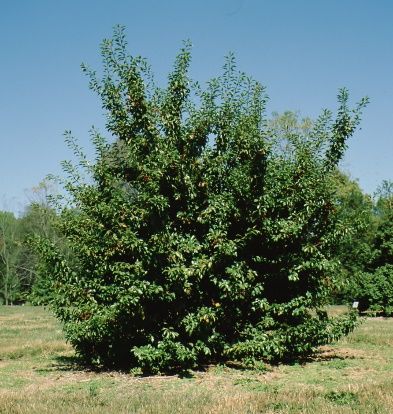Introduction
This broadleaf evergreen from China, Japan, and Korea is not well known in this country. Its moderately dense habit varies from narrow columnar to rounded and irregular. Branches will remain on the lower portion of the trunk forming a nice pyramidal silhouette on some specimens. Others may have to be pruned in order to maintain a uniform shape. Leaves have a smooth, undulating margin quite unlike many other hollies. The dense habit is due to the persistent leaves, which remain on the tree for 2 or 3 years. The small, bright fruits are pendent on long peduncles displaying nicely in the foliage. A male plant of the same species must be nearby in order to ensure fruit set. Wildlife appears to enjoy the fruit.

Credit: Edward F. Gilman, UF/IFAS

Credit: Edward F. Gilman, UF/IFAS

Credit: Edward F. Gilman, UF/IFAS
General Information
Scientific name: Ilex pedunculosa
Pronunciation: EYE-lecks ped-unk-yoo-LOE-suh
Common name(s): longstalk holly
Family: Aquifoliaceae
Plant type: tree
USDA hardiness zones: 6 through 8 (Figure 4)
Planting month for zone 7: year round
Planting month for zone 8: year round
Origin: not native to North America
Invasive potential: not known to be invasive
Uses: hedge; screen; sidewalk cutout (tree pit); recommended for buffer strips around parking lots or for median strip plantings in the highway; near a deck or patio; container or above-ground planter
Availability: somewhat available, may have to go out of the region to find the plant

Credit:
Description
Height: 10 to 15 feet
Spread: 10 to 15 feet
Plant habit: round
Plant density: dense
Growth rate: slow
Texture: fine
Foliage
Leaf arrangement: alternate
Leaf type: simple
Leaf margin: undulate
Leaf shape: elliptic (oval); oblong
Leaf venation: brachidodrome
Leaf type and persistence: evergreen
Leaf blade length: 2 to 4 inches
Leaf color: green
Fall color: no fall color change
Fall characteristic: not showy
Flower
Flower color: white; pink
Flower characteristic: pleasant fragrance
Fruit
Fruit shape: round
Fruit length: less than 0.5 inch
Fruit cover: fleshy
Fruit color: red
Fruit characteristic: persists on the plant; attracts birds
Trunk and Branches
Trunk/bark/branches: not particularly showy; typically multi-trunked or clumping stems
Current year stem/twig color: brown; reddish
Current year stem/twig thickness: medium
Culture
Light requirement: plant grows in part shade/part sun
Soil tolerances: acidic; well-drained; sand; loam; clay; slightly alkaline
Soil salt tolerances: unknown
Plant spacing: not applicable
Other
Roots: usually not a problem
Winter interest: plant has winter interest due to unusual form, nice persistent fruits, showy winter trunk, or winter flowers
Outstanding plant: plant has outstanding ornamental features and could be planted more
Pest resistance: long-term health usually not affected by pests
Use and Management
Longstalk holly is not common in the trade and so has not been used extensively in the landscape. Although it can be thinned or clipped if planted too close to a walk or structure, it may be best used as a specimen in a large garden where its natural habit can be displayed.
Plants are best located in a sunny spot in soil that drains well. Longstalk holly can withstand exposure to wind, even in the winter. It appears to be one of the most cold-tolerant hollies.
Pests and Diseases
Although few problems are reported on this plant, it has not been widely grown or tested.